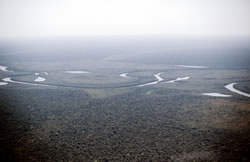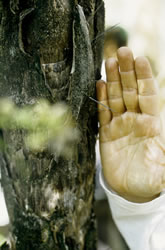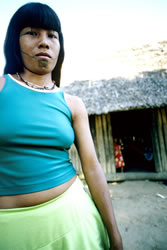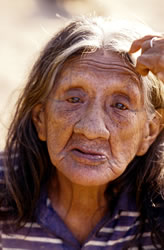Tattooed Tribes of the Amazon
Article © 2010 Lars Krutak
Three hundred years ago, there may have been more tattooed tribes living in the dense jungles and swamps of South America than anywhere else on earth. Some groups tattooed for medicinal purposes or to ward away evil spirits; others etched designs into their bodies to show success in battle or to venerate or imitate the mythic cultural heroes of the past. Still more attempted to transform themselves into predatory animals or gain spiritual guardians with their ritual markings, while others believed that their ancestral marks transformed “girls” into “women” and “boys” into “men.”
Today, however, there are less than ten tribes that continue to wear tattoos or practice the indelible art in South America including the Matis, Matsés, Marubo, Karajá, Ikpeng, Kayabi and other as-of-yet “uncontacted” groups presumed to tattoo. Most of these peoples live by hunting, fishing, and gathering much like Christopher Columbus would have found the inhabitants of the New World over 500 years ago. |

Aerial view of the Xingu River (background) and Reserve. The Xingu is the fourth largest tributary of the Amazon River. Photograph © Lars Krutak 2007-2010 |
Yet over the last century, unsolicited contact with “white” outsiders (blancos) has brought deforestation, mining, rubber tapping, oil exploration, missionization, and violence to indigenous lands and their peoples fueling conquest, disease, cultural devastation, and the loss of tattooing tradition itself.
|
|
More specifically, European-introduced diseases, in which the local people have no natural immunity, have radically altered the demographic landscape of Amazonia. For decades, epidemics like Hepatitis C, smallpox, and measles have claimed the lives of village elders, shamans, and tattoo masters alike, each of which are the gatekeepers of cultural traditions like tattooing and the knowledge associated with them. As one noted Brazilian ethnographer recently put it: “Outsiders change everything, and once you make contact [with Indians], you begin the process of destroying their universe.” |
Thus, FUNAI (Fundação Nacional do Índio), the Brazilian agency that deals with indigenous peoples, has for decades carved out numerous reserves in the Amazon to curb such “contact” in an attempt to preserve what is left of the indigenous peoples who live there. Peru has recently followed this model but reports have circulated that the government has been handing out exploratory and development concessions on Indian lands and reserves to international firms lining up to prospect the Amazon's rich stores of minerals, lumber, gas, and oil. In April 2009, Perupetro, Peru's state oil company, announced plans to auction off up to twelve new lots for oil and gas exploration in land inhabited by uncontacted tribes; tribes that the government says "does not exist."
 |
 |
 |
Tucum thorns come from a species of palm tree. Photograph © Lars Krutak 2007-2010 |
Silvana's facial tattooing and her family's dwelling (maloca) in the background. Photograph © Lars Krutak 2007-2010 |
Kayabi woman with traditional facial tattoos called opejan. Photograph © Lars Krutak 2007-2010 |
According to Stephen Corry, Director of the NGO Survival International that assists tribal peoples worldwide: "The concessions violate international law and the UN Declaration on Indigenous Peoples. And it could have catastrophic consequences for the environment and the Indians who live there--including extinction."
Jose Meirelles, a researcher with FUNAI, has reported that Peru's last remaining uncontacted tribes are already retreating east into Brazilian territory in search of food and land because loggers have been allowed to kill and expel isolated tribes from within Peru's borders while clearing forest cover for future oil and gas exploration.
"Protected" Indian reserves in Peru are also under attack by logging corporations. For example, 16% of the total area of the Kaxinawa Igarape reserve in the Ucayali region has been deforested, while other "Forestry Management Plans" are receiving approval to cut timber on other Indian lands like those of the Matsés who are one the last groups to wear the tattoos of their ancestors.
One colleague of mine has stated that he feels like becoming "combative" after seeing how ten million dollars from USAID (U.S. Agency for International Development) is being funneled into "shady" Peruvian NGOs via the WWF (World Wildlife Fund) to promote "conservation".
"They are secretly planning to cut the Matsés timber without informing the Matsés people. I have even found reports by the NGO to USAID on the internet telling lies how they have visited all of the Matsés villages and received their approval. They never visited any Matsés communities, and this is how the US government and conservation organizations are protecting the rainforest with our tax dollars by secretly planning to cut the Matsés timber?"
My informant continued: "I am trying to get the word out on what is happening to all the money from international conservation organizations that is being used to create indigenous reserves. As far as I can tell, the Peruvian NGOs aren't giving a dime of it to the indigenous people. With a few thousand dollars from the millions they are stealing, they could save many lives that are needlessly being lost to malaria. They just won't do it. They want to steal every cent. The recent creation of indigenous reserves in Peru is just a sham to exploit them and their land. There is one NGO in the Peruvian Amazon that dominates the Matsés by rigging their elections and has sucked up most of the money without giving a dime to the Matsés people. In fact, an anthropologist was bringing in malaria medicine to save Matsés lives and that Peruvian NGO filed a lawsuit against him."
Not surprisingly, the frontier towns in the Peruvian Amazon are booming and logging roads are stretching even deeper into the once pristine rainforest. One look at a commercial map of Peru and you'll see a patch-quilt of concessions covering nearly three-quarters of the jungle - far more than in any other Amazonian country. And if you visit the area in person, you'll probably encounter a Korean or Japanese trader looking for the latest deal on highly-prized stands of mahogany that are native to the region.
Back in Brazil, however, many human rights advocates argue that there are not enough Indian reserves for indigenous people who dwell outside of the Amazon forest. For example, tens of thousands of “forgotten Indians” like the Guarani live in a state of despair in ghetto-like Indian reserves created on the outskirts of Brazilian towns like Dourados in the state of Mato Grosso do Sul. There is no land for them to hunt or farm and these peoples are largely cut off from society and the Brazilian economy. Some Indians survive on a $40 government hand-out each month, while others find menial jobs like cutting sugar cane around $8 a day during a four-month season or they turn to pushing drugs.
But Indians living in more “generous” reserves back in the rainforest, like the Kayabi who inhabit the Parque Indígena do Xingu in the state of Mato Grosso, find life much easier than their urban counterparts. They are more likely to be killed by a jaguar or alligator rather than suffer death by suicide, a heart attack, or worse back in the Guarani reserve near Dourados. In the first three months of 2007, for example, two indigenous youths were decapitated presumably by drug lords, a chief shot to death, and numerous people were assaulted by blancos near the Dourados reserve.
Next Page | 1
|
2 |
3 |
4 |
5 |
6 |
7 |
8 |
Museum photo gallery of the images
on this page may be seen here. |




